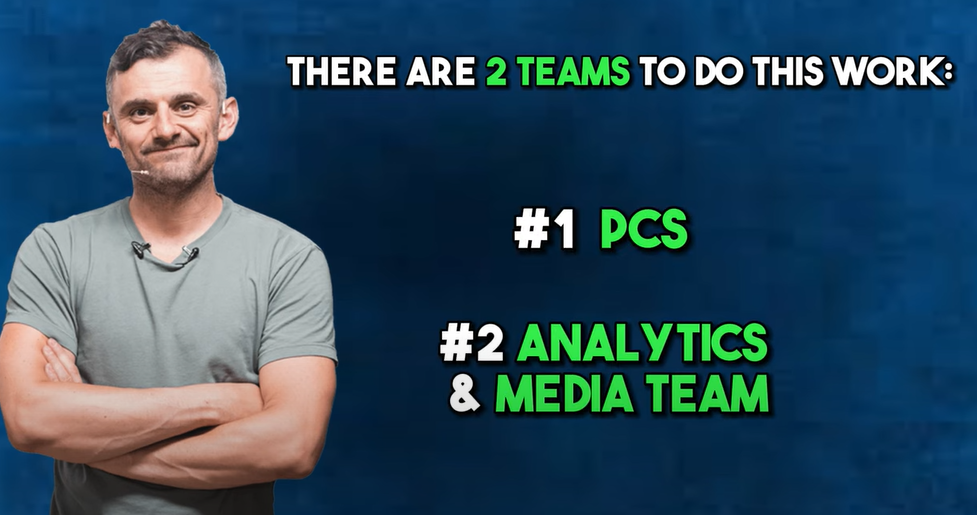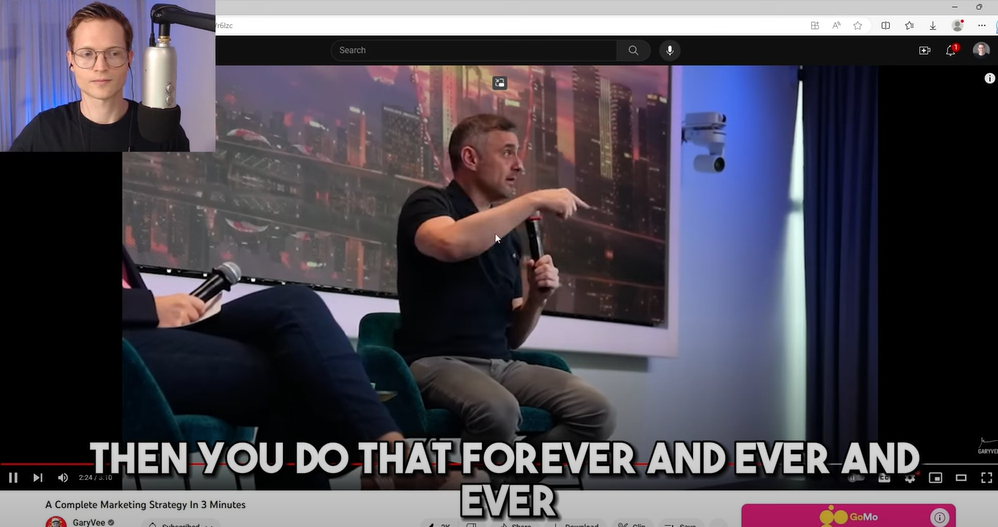
You’re about to see the best social media strategy that exists right now.
When I first saw this clip by Gary Vee I couldn’t believe he gave away the entire strategy.
But he explained it all in under 3 minutes and there are a few points that I have to explain.
So let’s start watching and learn from the best.
00:00 – 00:05: Big Wake-up Call
Already, Gary’s first step is a big wake-up call.
So often when I talk to new solopreneurs or new coaches trying to market themselves, they get the feeling that marketing means they have to compromise their mission or their values.
In other words, they have to sell out.
As we can hear Gary Vee speak here, he doesn’t mention any of that. He puts mission and values at the very top.
As a new solopreneurs or new coaches, try this instead:
- Don’t feel like you have to sell out to do social media marketing.
- Use your values and mission as a guide for all your social media content.
00:05 – 00:11: Create 40 to 50 Consumer Segmentations, not 3
After you have defined your values and mission, the next step is to create 40 to 50 consumer segmentations. Not 3.
What does he mean by this?
Consumer segmentations are basically your avatars.
Here he comes up with three good examples.
00:11 – 00:31: Consumer Segmentations Examples
- 18 to 23-year-old males who live in Bangladesh who are into e-sports
- 21 to 27-year-old female in Tokyo making 200k per year
- 40 to 45-year-old moms in Malaysia who have an affinity towards high fashion
If we wanted to break this down into a framework, it would look like this:
- Age + Gender + Location + Interest
- Age + Gender + Culture + Interest

Using that framework, here’s one example for my consumer groups:
“39-year-old men in the Midwest who wish to be financially free as they enter their 40s.”
The point isn’t to be rigid with this framework.
The point is to have a starting point and to make sure you describe real people who actually exist as a consumer.
00:31 – 00:39: What is PAC?
Next is PAC: Platforms And Culture, which is something Gary Vee talks about very often.
It’s another way of asking the question: Do you actually understand what the platforms are doing?
This is also often called: Social media trends, but it’s more than that.
What Gary Vee means here is that you understand why people go to a certain social media platform.
If someone turns on Instagram, what do they want to see? What’s the culture on that platform?
For example, a simple example is dance videos on TikTok. There was a time when people tuned into TikTok to see such dance videos. That was the culture back in those days.
Here are some things you need to consider:
- That culture on platforms continuously changes and adapts.
- So you have to be deliberate about observing this.
- Writing down what the current culture looks like.
- And then adapting your content to that.
And of course, there are also sub-cultures on all platforms.
The point is: From the 40 to 50 consumer segmentations that you created, which culture or sub-culture do they belong to on your chosen platforms?
For example, going back to my consumer group of 39-year-old men in the Midwest, they certainly don’t belong to the TikTok dance video culture.
But they might belong to the culture of reaction videos.
Also, keep these in mind:
- That platform and social media culture go hand in hand.
- Each platform has different groups and subgroups.
- Be aware of those groups and they communicate on the platform.
Next, which platforms should you pick? Here’s what Gary Vee thinks:
00:39 – 00:57: Which platforms should you pick?

So Gary Vee says, “You should be on every single platform.”
But as we heard him say, he’s talking about million-dollar budgets.
So I think if you’re just starting out, especially as a new coach, consultant, or solopreneur… it’s fair to say to PICK ONE and figure that one out.
To get an extraordinary result:
- Remember that it is more than just creating and uploading.
- Start creating your consumer segmentation.
- Understand the culture of your chosen platform.
Considering everything you have to learn, it makes more sense to focus on one platform and master it.
But how do you figure all this stuff out? Here’s an answer many don’t like to hear: Through testing.
00:57 – 01:06: Your Creative and Strategy Team
Gary mentions here the creative and strategy team.
To be clear here: That’s YOU.
You are your own creative and strategy team. It means you’re the one creating your own content.
01:06 – 01:22: Start Making
Gary Vee just said, “Now you start posting against the framework.”
This means that you get to work and create content based on the framework you’ve just laid out.
As a reminder, your framework should consist of this:
- Your brand values. Your business mission.
- Your consumer segments.
- Your platforms and their culture / sub-culture.
But the question is of course:
- Did you define the correct consumer segments?
- Do you understand your chosen platform and its culture?
And the only way to answer these two questions is by making content and looking at how it performs.
So you start making!!
That’s Gary’s big message here.
01:22 – 01:44: PCS and Analytics & Media Team
Okay, let’s unpack that real quick and translate it into simple English.
First of all, the real work starts AFTER you’ve been creating content.
Why?
Only now will you discover if you are targeting the right consumer groups and if you understand the platform’s culture.
In Gary’s world, there are two teams that do this work, PCS and Analytics & Media Team.

PCS: Post Creative Strategist = Looking at all the qualitative feedback.
And this qualitative feedback means:
- Engagement
- Viewer retention
- Virality
- Consumer sentiment
- Consumer intent
In simpler words, you verify if your content resonates with your consumer groups and with their culture. It always comes back to the framework and testing your content against the framework.
Analytics and Media Team = Quantitative feedback.
This means metrics in your business like:
- Traffic
- Conversion rates
- CTR
- Opt-in rate
- Etc
Again, for you as a new coach, consultant, and solopreneur, you are the one doing all this work:
- You write down your consumer groups
- You write down ideas to participate in your platform’s culture
- You are the one creating the content
- You’re looking at the qualitative feedback and also at the quantitative feedback
- And then you’re the one deciding which content works and which one doesn’t, and what you can try next.
And really the key take-away here is that through this process, you’re becoming smart about your content.
You start making your content machine smart
AND THE TEAM, WHICH IS YOU, GETS SMART THROUGH THE WORK.
You don’t get smart by researching and analyzing, you get smart through the WORK. I can’t highlight this key point enough.
Now let’s look at what comes next in Gary’s process. (Reach, Leads, and Sales)
01:59 – 02:08: It’s NOT about Going Viral
This is such an important part of the strategy.
What Gary said is, “If one of your content pieces overperforms, it becomes the brief for future content.”
One thing I have to point out here is how Gary uses finger quotation marks when he says “goes viral”.
Look, going viral doesn’t mean everyone has to see it. In this context, going viral simply means it’s overperforming your average results by a big margin.
That’s why Gary uses the finger quotation marks because it’s not about actually going viral – it’s about content that performs better.
02:08 – 02:22: What is A “Brief”?
Again, this is such a crucial step to make this social media strategy work.
When a piece of content overperforms or goes viral, it becomes the brief for more efficient and effective work.
What did he mean about the strategist sitting in an ivory tower writing a brief on Reddit for 4 hours?
I think Gary doesn’t want us to write a brief. He wants us to have high-performing content that is the brief.
Do you see the difference?
In other words, your best content becomes the template for future templates.
What’s next?
- Keep refining your BRIEF based on qualitative feedback.
- Always looking for a new piece of content that performs even better.
02:23 – 02:27: What happens next?

When we’re watching Gary’s behavior and body language, I think this is clearly one of his most important messages: Keep refining the BRIEF.
There is a problem though:
- What if none of your content works?
- What if you only get bad results?
02:27 – 02:36: “Your cohorts are in an accordion”
I like this mental picture when Gary says, “Your cohorts are in an accordion.”
If something is not working, you eliminate that cohort from your framework. Not because they don’t exist but because you aren’t finding AFFINITY.
This is super important here.
The consumer may exist. And they may be a great consumer group but you are not finding affinity with them.
02:36 – 02:38: Why it doesn’t hit the mark?
Look how Gary points to his chest when he explains it and says, “Your creative team hasn’t hit the mark.”
Look, it’s just the reality that we don’t connect with everyone. Some people resonate with us, and some people don’t.
And that’s okay! If you don’t resonate with someone, that’s okay. You want to find the consumer groups that resonate with you.
I think that is the point of this process.
02:38 – 02:55: The Truth of the Consumer
While creating content, you may notice that there’s actually a different group that resonates more with your INTENT.
What do you need to do?
- Add that consumer group to your framework.
- And then you DOUBLE DOWN ON what works.
Or as Gary calls it, “THE TRUTH OF THE CONSUMER”.
And if you don’t know which social media platform to pick, and which type of content to create, then you have to read my Content Marketing Series where I explain every content type and every platform.
Here are the links for the series:
- The 4 Best Content Marketing Strategies (With Examples & Templates)
- Content Marketing Part 2: Simple Strategy For Writers
- Why Use Short Videos for Marketing? | Part 3: Short-Form Video Content
- Does Long-Form Video Marketing Still Work?
- 5 Reasons To Start a Podcast As Soon As You Can | Part 5 Content Marketing
- How I Make Daily Content In Just 30 Minutes | Part 6 Content Marketing Strategies
Gary Vee is indeed a Marketing Genius! Right? Would you mind sharing with me what other tips you learned from Gary Vee or anyone who you think is also a Marketing Genius? I am excited to read them all!
And don’t forget to subscribe on my YouTube channel, @creategrowprofit.
If you are a coach or consultant, and your goal is to get your very first client online, then I have a simple strategy for you that’s very beginner friendly, you can download this strategy for FREE from my website at CreateGrowProfit.
Thank you and see you on my next blog!

Morris this is such a mindful, detail-oriented breakdown from a guy who literally grew up one town over from me in New Jersey. I had no idea that he lived 6 minutes from my house, until a few years ago. What a small world.
You did a smash up job detailing his strategy.
Gary Vee is a genius for his in-depth approach on social media coming from pure abundance. Who patiently invests enough time to brainstorm 50 avatars? Dude is a legend because he did, and, now he is influencing others to do the same.
I totally get his idea of making or creating on social, especially from a place of volume publishing smart, valuable content that hits the mark. This is why I leverage each piece of social content I create across many arms, including Twitter, FB, FB Groups, LI, LI Groups, IG, etc, etc, etc…..we need to go wide in terms of channels but target it all by honoring the culture on each platform, presenting appropriately for the user base. Facebook, Twitter and IG are genuinely quite different in many regards.
Thank you Ryan, for your kind feedback on this post!! I totally agree with you, it takes a certain quantity, or mass, to build that momentum. And I like that Gary Vee is upfront about that. There’s no such thing as creating a perfect post and growing the business. It’s about quantity, that’s how social media works. Hard truth! Thank you for sharing your strategy and approach.